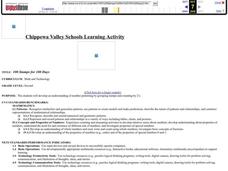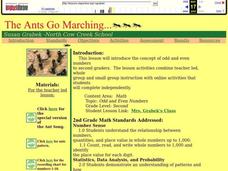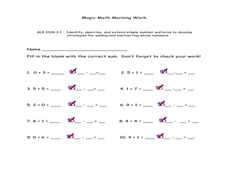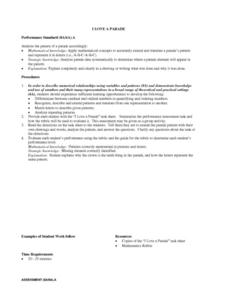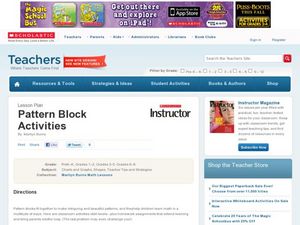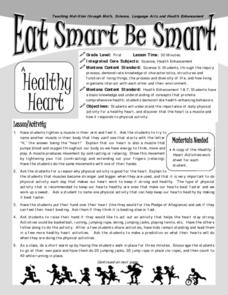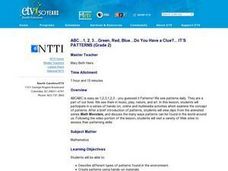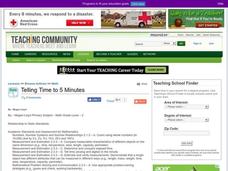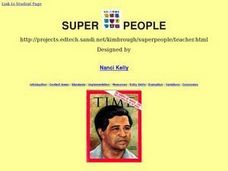Curated OER
Leaves, Flowers, Seashells, Mirrors and Symmetry
Young scholars develop an understanding of patterns and symmetry. In this symmetry and pattern lesson, students use real world patterns then analyze and extend them. Young scholars also use real world items while discovering and...
Curated OER
100 Stamps for 100 Days
Second graders count by 2's to get to 100. In this counting lesson plan, 2nd graders use the program Kid Pix to create stamps two at a time until they get to 100.
Curated OER
Spore Drop
Pupils observe the pattern of the inside of a mushroom and write down what they see. In this mushroom lesson plan, students cut a mushroom at the top and draw what they see in the spore of the mushroom.
Curated OER
Relations
Students identify, compare, and analyze shapes and numbers. In this analogies and comparison math lesson, students warm up by completing 4 worksheets to familiarize themselves with analogies. In small groups, students are challenged to...
Curated OER
Odd and Even
Explore the concept of odd and even with your class using this resource. Learners take an online test demonstrating their knowledge of odd and even, sing a song about the concept, and engage in computer-based activities.
Guam Community College
Joseph Had a Little Overcoat
Spruce up a class reading of the children's book Joseph Had a Little Overcoat by Simms Taback with this fun series of activities. Starting with a list of reading comprehension questions and key vocabulary to address during a teacher...
Curated OER
Rocket Patterns
Students create their own paper rockets. They identify different patterns and practice making their own. They also discover the concept of sequences.
Curated OER
Be Sharp and Never Flat
An outstanding lesson on music awaits your young composers! They learn about patterns found in music, the different sections of an orchestra, and see the differences between musicians and a composer. Excellent streamed videos and good...
Curated OER
My Arkansas Family Tree
Here is a two-part lesson that introduces learners to genealogy by having them create family trees, and map the movements of their ancestors. While this resource is designed for kids who live in Arkansas, it certainly can be adapted for...
Curated OER
Magic Math Morning Work
In this fact families instructional activity, students solve 10 problems in which single digits are added with sums to ten. Students then check each problem using subtraction.
Virginia Department of Education
Weather Patterns and Seasonal Changes
Get your class outside to observe their surroundings with a lesson highlighting weather patterns and seasonal changes. First, learners take a weather walk to survey how the weather affects animals, people, plants, and trees during...
NASA
Pop! Rockets
Off they go — launching rockets is fun. The lesson plan contains templates to build paper rockets that can be launched from a PVC pipe launcher. Individuals or groups build the rockets and determine the shapes for their fins. Included...
Curated OER
Math: The Cathedral Project
Second graders take a field trip to a nearby church or other historical building and examine it from a mathematical perspective. In groups, they calculate the seating capacity, describe the window patterns, differentiate types of...
Curated OER
I Love a Parade
Pupils receive a worksheet that describes a parade. They tell what the 10th item in the parade will be. Students draw the parade, and tell the pattern they see using letters. Pupils design their own parade with the same pattern. They...
Curated OER
Pattern Block Activities
Young scholars practice various math skills by using manipulative activities. In this math manipulative instructional activity, students sort shapes, build hexagons, and build shapes using manipulatives. These activities would be great...
Montana Office of Public Instruction
Eat Smart Be Smart
Get children's blood pumping with this primary grade lesson on the human heart. After learning about the important role this muscle plays in the human body, young scholars monitor their heart rates and discover the importance...
Curated OER
ABC...1, 2, 3...Green, Red, Blue...Do You Have a Clue?... IT'S PATTERNS
Second graders view clips from the animated series Math Monsters, and discuss the many ways patterns can be found in the world around us. Following the video portion of the lesson, 2nd graders visit a variety of Web sites to assess their...
Curated OER
Let Us Be Sensible
Pupils describe the five senses. They perform an investigation using sensory organs associated with each of the senses. Students identify, describe and extend repeating relationship (pattern) found in common, objects, sounds and movements.
Curated OER
Interpreting Data from Birdfeeders
What kinds of birds live in your area? Read a book about birds to your learners and explore their feeding patterns. Charts and graphs are provided in this three page packet, but consider assigning the basic questions if using with young...
Curated OER
Investigation-Reasoning and Proof
The class explores even and odd numbers.They discuss the results when even numbers are added and when odd numbers are added together. Then work in pairs to find other odd and even pattern examples.
Curated OER
Telling Time to 5 Minutes
In this second grade lesson your class will practice telling time. The goal is to tell time to five minutes using an analog clock. Your young students count by 5 minute intervals and discuss elapsed time.
Curated OER
Peachy Teacup by the Stream
Help your kids distinguish between the sounds for short vowel /e/ and long vowel /e/. They are introduced to the vowel patterns that comprise long vowel sounds, with a particular emphasis on /ea/. They practice reading and spelling a...
Curated OER
Compatible numbers to 20
Students practice theories dealing with equals sign used as a balance, inequality symbols and practice utilizing a box or some other geometric shape to represent an unknown number. They assess numeracy problems embedded in language-rick...
Curated OER
SUPER PEOPLE
Second graders study the talents and interests that have helped people to "make the world better." They begin by reading a story about 5 individuals who have "made a difference." This webquest extends this exploration by guiding the...

